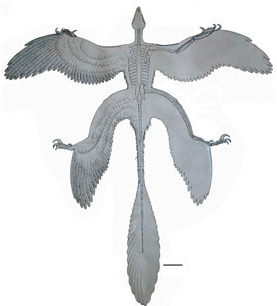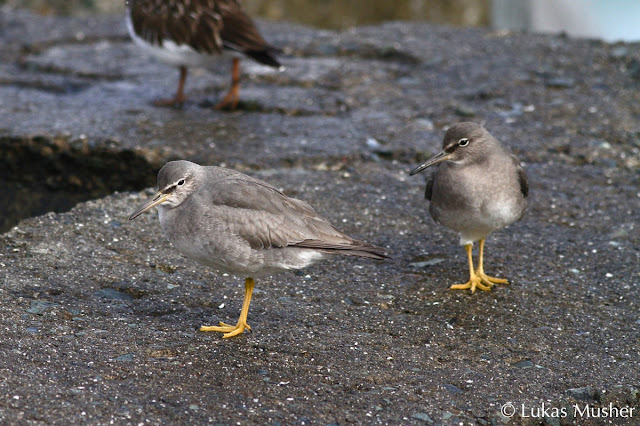Here at BoomCha we've begun, and hope to continue, talking about some big questions in ornithology (see Gavin Leighton's recent interesting posts on the evolution of flight). Another major question, though not at all limited to avian biology, is how to define the idea of the species. In my experience species definitions (and similarly definitions of higher taxa - genera, family, etc) often seem arbitrary. The constant lumping and splitting baffles the birding bystander, yet remains unquestioned. In many cases the same taxa are lumped and then subsequently split or vise versa!
Bird watchers and birders in general may not care - though certainly many do - all that much about why species are classified the way they are or who is making those decisions. For the purposes of birding and bird watching alone, the American Ornithologists Union (AOU) is fairly helpful in keeping a standardized checklist of birds that everyone uses in North America. Still, every once in a while (i.e. every time a supplement to the AOU Checklist comes out), you have to ask, why ornithologists at the AOU make the decisions they make. Why split one taxon with multiple independent populations but not others? Indeed the duty of sorting through the current literature, and choosing what species definitions to use is a difficult one, but it is often done in a way that seems almost arbitrary.
A short hike in February with Steve Howell (author of Gulls of the Americas, A Field Guide to the Birds of Mexico and Northern Central America, and most recently Petrels, Albatrosses & Storm-Petrels of North America among many others) on Pine Mountain in Marin county, CA to look at three of the four Fox Sparrow races (sooty, thick-billed, and slate-colored) got me thinking about the species concept. This trip was followed by some interesting discussions with Steve on how to define species, and some major problems with the AOU. In part one of this series I will discuss very basically about the idea of the species, and some of the ways species (at least for birds) come about. In later posts I will discuss some of the ways that biologists delimit species, and how these ideas pertain to Fox Sparrow races (the four probably represent separate species but have not been split). Further, I will attempt to discuss possible ways to deal with the problem of delimiting species. I will not, however, write an in depth criticism of how the AOU Committee on Classification and Nomenclature (CCN) should do their job (I would not be authoritative on this matter, but if you are interested Steve Howell wrote a very informative commentary on the forty-first supplement to the AOU checklist that covers some examples of inconsistent decisions made by the CCN in the past and the need to standardize a system for taxonomy).
Though there is much debate in biology on how to best delimit species, most biologists agree that a species is the smallest evolutionarily independent unit. Speciation is the evolutionary process leading to the rise of new species - a consequence of gene flow (essentially gene flow is just interbreeding between two populations; gene flow between populations means speciation won't occur), mutation, natural selection, and genetic drift (changes in gene frequencies due to random chance alone) acting on separated populations. The most common form, known as allopatric speciation, involves geographic isolation between two populations that then diverge as the aforementioned processes act differently on each population. Geography, ecology, and genetics all play a major role in this process. Despite such wide agreement on how species arise and what they are in the most basic sense, there are a lot, in fact more than 25, of species concepts out there, each with a different way of classifying species.
Still, to most, if not all, people the basic idea of the species is not difficult to grasp. I would argue that for the most part what a species is, is intuitive. We know that Northern Cardinal is not the same as a Greater Roadrunner. They look nothing alike, they make different vocalizations, they have different habits, live in different habitats, and so on. A little more subtly, most people could tell that a Yellow Warbler is different than a Wilson's Warbler if compared next to each other. However, more difficult, but arguably as intuitive is deciding when cryptic species are different. We know that Willow and Alder flycatchers are not the same. They may look the same (almost) and have awfully similar habits, but they make different vocalizations, have different DNA, and so on.
 |
| One use of bird song is to help distinguish between other species. Prothonotary Warbler, Magee Marsh, OH [Photo by Lukas Musher] |
In the words of the great ecologist, Ernst Mayr, species are "natural kinds." Ultimately, though, a species in it's most basic definition is just an entity that evolved independently of other such entities. In order to be independent, and thus for speciation to occur, they must not breed with other such entities during the course of their evolution. In the next part of this series I will discuss some of the major ways of delimiting species in biology.
By Luke Musher


















































